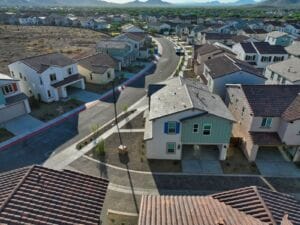The apartment market in Downtown Phoenix is hot, really hot, and members of the Arizona Multihousing Association (AMA) are cautiously optimistic that the market will remain one of the hottest in the country for at least a couple more years.
In a standing room only crowd of over 60 people, AMA hosted its second-ever Quarterly Apartment Market Presentation, which was created to be an educational resource with news and information for AMA members to improve their business, the industry, community and state.
The program consisted of three speakers that explored topics ranging from how tenants use the internet to search for apartments to how Arizona compares with other national markets to the conditions fueling the hot Downtown Phoenix apartment market.
With more than three-million perspective buyers still living at home in Greater Phoenix, experts believe the Greater Phoenix apartment market is ripe with opportunity. Jim Kasten, CCIM, designated broker at Kasten Long Commercial Group, is passionate about helping AMA members capitalize on those opportunities, which is why his firm is sponsoring these quarterly programs.
Scheduled to occur at the end of each quarter, Kasten says, future programs will explore other submarkets in the Valley as well as the topics and trends shaping them.
How do tenants search for apartments?
Perspective tenants look for apartments in all kinds of different ways, but among the most common is the internet.
Bry Carter, regional director at CoStar Group with over 20 years of multifamily experience, discussed the importance of identifying, learning and understanding the way prospective tenants search for apartments.
She used Apartments.com — the No. 1 online apartment listing service that was recently purchased by CoStar — as an example to show the countless different ways that apartments will market available units.
Carter says, “We buy based on how things look,” which is why the photo selection for the listing is vital. It’s also important to include the right key words or search engine optimization words in marketing and listing materials.
While someone may search “Downtown Phoenix apartment with parking,” someone else may search for “Downtown Phoenix apartment with parking, pool, pet friendly, stainless steel appliances in Roosevelt Row Arts District.”
Phoenix vs. other U.S. markets
Phoenix ranks among the top 10 U.S. apartment markets for three key performance metrics, according to the presentation by Arvle Knight, CCIM associate broker at Kasten Long Commercial Group.
In comparison to other U.S. Metro areas, Metro Phoenix ranks:
- 6th for markets with highest expected absorption in 2017
- 6th for income growth
- 10th for rent growth
Knight points to pent up demand as one of the factors creating such an attractive apartment market. From 2009 to 2014, only five multifamily complexes where built, he says, in addition to five more complexes completed in 2016.
Today, on the other hand, 61 multifamily projects totaling 15,406 units are currently under construction in Greater Phoenix, with 68 more projects in the planning stages.
Based on the more than three-million perspective buyers still living at home, Knight thinks it’s only a matter of time before they start buying. He predicts the expansion of the light rail to Baseline Road will create another hotspot for multifamily activity.
Downtown Phoenix apartment market stays hot
Christine Mackay, economic development director for the City of Phoenix, wrapped up the program with an update about the overall market in Downtown Phoenix.
During the past five years, she has helped locate or expand 150 companies in the area, brought in 22,000 jobs and $6 billion in capital investments to the community. In her presentation, Mackay explained how those factors play into the apartment market and how Downtown Phoenix can create and capitalize on opportunities.
Of the 168,438 people reportedly employed in the Central City only three percent live in the community and 52 percent don’t live in the City of Phoenix at all.
As a result, Mackay says, it creates challenges such as job opportunities, stress on transportation networks, missed real estate opportunities and $5.6 billion in lost income each year as Central City employees take their payrolls back to the other cities that they live in.
She explains if only two percent more of the employees in the Central City moved to Downtown Phoenix, then it would generate $1.4 million in annual on-going revenue for the city.
The solution, Mackay says, “It’s about creating a place where the workforce wants to live.”
The construction of Downtown Phoenix’s first grocery store at Block 23 will help, she adds. There are also rumors circulating that discussions are currently underway with two other potential grocers interested in setting up shop in Downtown Phoenix too.




